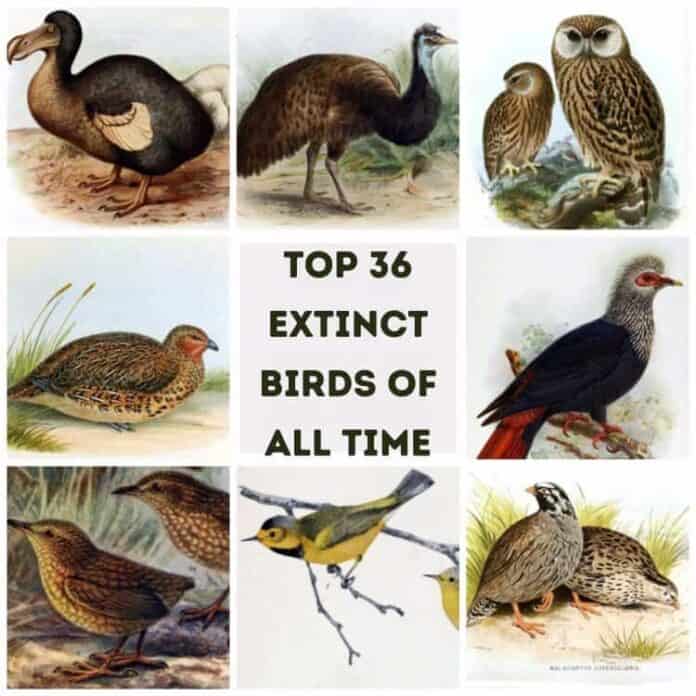
Extinct Birds: In life, people are often told that they only realize the true value of something when it goes missing from their lives.
In a scientific sense, the real value of conservation is better discovered by appreciating the very loss of biodiversity. Scientists predict that in the coming decades, species on our planet will slowly perish and have a rate of extinction almost 1000 times the natural one. When that happens, we may lose more than half of all living organisms on our planet.
Unfortunately, due to the advancement of technology and the continuously increasing human population, scientists’ predictions might come true (even sooner).
There have already been numerous reports about the extinction of many living organisms – many bird species.
This page will explore the 36 (already) extinct birds and discover what caused their mass extinction. Also, we will explore several reasons why birds are becoming extinct.
Table of Contents
- Top 36 Extinct Birds
- 1. Dodo Bird (†Raphus cucullatus)
- 2. Carolina Parakeet (†Conuropsis carolinensis)
- 3. Bachman’s Warbler (Vermivora bachmanii)
- 4. Tasmanian Emu (†Dromaius diemenensis)
- 5. Arabian Ostrich (†Struthio camelus)
- 6. Great Auk (†Pinguinus impennis)
- 7. Seychelles Parakeet (†Psittacula wardii)
- 8. Laysan Rail (†Porzana palmeri)
- 9. Passenger Pigeon (†Ectopistes migratorius)
- 10. Stephen’s island Wren († Traversia lyalli)
- 11. Ivory-Billed Woodpecker (†Campephilus principalis)
- 12. New Zealand Quail (†Coturnix novaezelandiae)
- 13. Labrador Duck (†Camptorhynchus labradorius)
- 14. Laughing Owl (†Sceloglaux albifacies)
- 15. Chatham island Penguin (†Eudyptes chathamensis)
- 16. Mauritius Blue Pigeon (†Alectroenas nitidissimus)
- 17. Elephant Bird (†Aepyornis maximus)
- 18. Marianne White Eye (†Zosterops semiflavus)
- 19. Himalayan Quail (†Ophrysia superciliosa)
- 20. Saint Helena Dove (†Dysmoropelia dekarchiskos)
- 21. Kangaroo Island Emu (†Dromaius baudinianus)
- 22. Norfolk Island Kaka (†Nestor productus)
- 23. Reunion Shelduck (†Alopochen kervazoi)
- 24. Hawaiʻi ʻōʻō (†Moho nobilis)
- 25. Hawaiʻi Mamo (†Drepanis pacifica)
- 26. Guadalupe Caracara (†Caracara lutosa)
- 27. Kākāwahie (†Paroreomyza flammea)
- 28. Rodrigues Solitaire (†Pezophaps solitaria)
- 29. Bushwren (†Xenicus longipes)
- 30. Réunion Ibis (†Threskiornis solitarius)
- 31. Réunion Swamphen (†Porphyrio caerulescens)
- 32. Bonin Grosbeak (†Carpodacus ferreorostris)
- 33. Wake Island Rail (†Hypotaenidia wakensis)
- 34. Red Rail (†Aphanapteryx bonasia)
- 35. Aldabra Brush-warbler (†Nesillas aldabrana)
- 36. Haast’s eagle (†Hieraaetus moorei)
- Reasons Why Birds Are Becoming Extinct?
Top 36 Extinct Birds
1. Dodo Bird (†Raphus cucullatus)
| Kingdom | Order | Family | Genus | Species |
|---|---|---|---|---|
| Animalia | Columbiformes | Columbidae | †Raphus | †Raphus cucullatus |
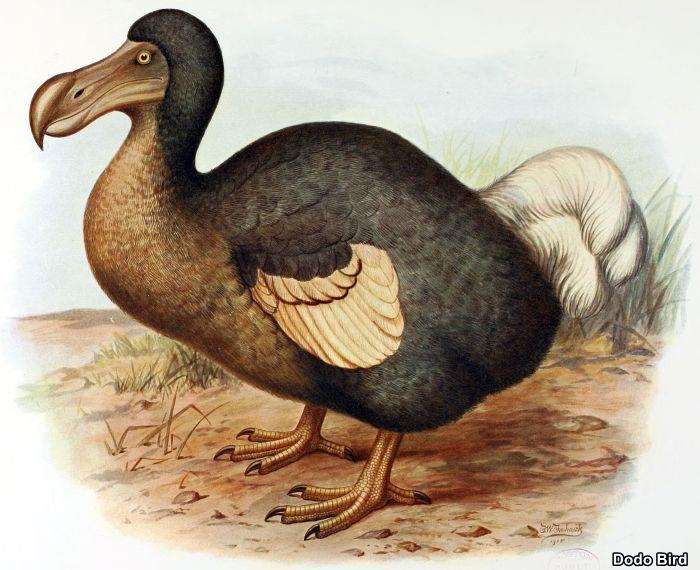
- By evolution, the dodo birds did not have any natural predators (of course, except humans!)
- The start of the 1500s marked the arrival of humans to the island. Dodo birds have since then been widely hunted for fresh meat, thus reducing their large number.
- The rise of human exploitation and invasive species population is the main reason for the extinction of the Dodo bird in 1681.
![]()
2. Carolina Parakeet (†Conuropsis carolinensis)
| Kingdom | Order | Family | Genus | Species |
|---|---|---|---|---|
| Animalia | Psittaciformes | Psittacidae | †Conuropsis | †Conuropsis carolinensis |
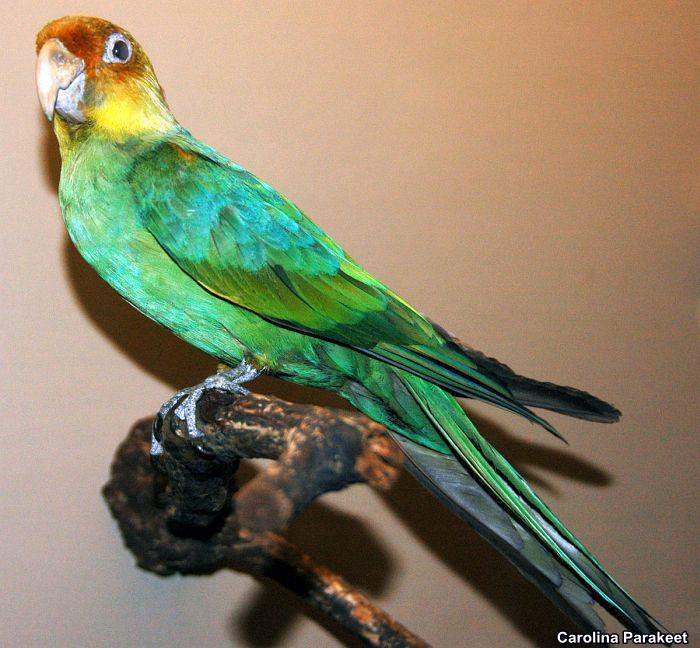
- Carolina parakeets were considered to be poisonous as animals (like cats) that feed on them die from doing so.
- During the 1800s, these parakeets had become a serious agricultural pest as they formed loud flocks that would feed on fruits and crops. As a result, enraged farmers held mass slaughter of these birds. The killing and hunting of these birds, combined with the degradation of forests, led to the decline of the bird population.
- By the 1920s, the Carolina parakeet was extinct. The above image from the Oklahoma Museum shows the dead Carolina Parakeet collected in the 1880s.
![]()
3. Bachman’s Warbler (Vermivora bachmanii)
| Kingdom | Order | Family | Genus | Species |
|---|---|---|---|---|
| Animalia | Passeriformes | Parulidae | Vermivora | Vermivora bachmanii |
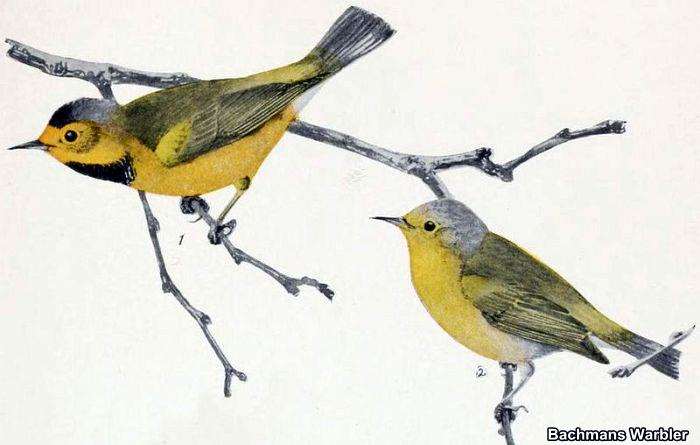
- The last breeding was officially recorded in 1937; no further reports have been done since then.
- Scientists believed that the ‘Bachmans warbler[3] has already become extinct due to widespread habitat destruction. However, they still hope to find some, as not all remnant patches have been searched.
![]()
4. Tasmanian Emu (†Dromaius diemenensis)
| Kingdom | Order | Family | Genus | Species |
|---|---|---|---|---|
| Animalia | Casuariiformes | Dromaiidae | Dromaius | †Dromaius diemenensis |
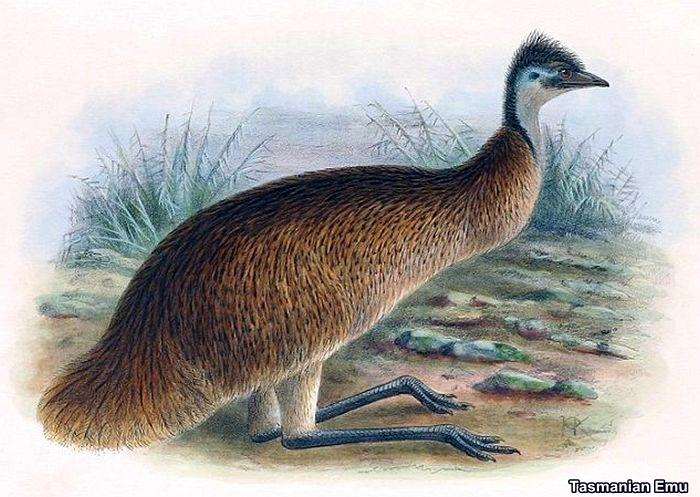
- In comparison to their relative Emus[5], the Tasmanian Emus were believed to be smaller and appeared to be darker with the absence of the black feather that distinguishes Emus.
- Records show that in just 20 years (from 1830 to 1850s), the Tasmanian emu went extinct from being locally extinct.
![]()
5. Arabian Ostrich (†Struthio camelus)
| Kingdom | Order | Family | Genus | Species |
|---|---|---|---|---|
| Animalia | Struthioniformes | Struthionidae | Struthio | †Struthio camelus |
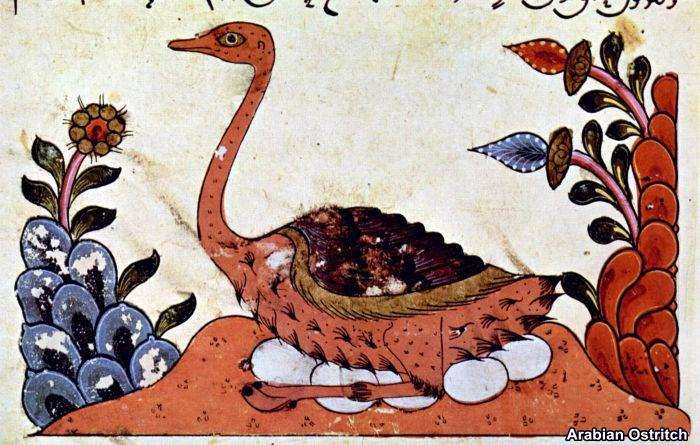
- In the Middle East[6], this bird was widely hunted for its feathers, skin, and eggs. In addition, the large size of these extinct birds makes them ideal as a dinner choice, along with other animals like camels and zebras.
- During the early 20th century, the population of the Arabian ostrich was greatly reduced as a byproduct of World War II. Finally, the last Arabian ostrich recorded was found in Bahrain in 1941.
![]()
6. Great Auk (†Pinguinus impennis)
| Kingdom | Order | Family | Genus | Species |
|---|---|---|---|---|
| Animalia | Charadriiformes | Alcidae | †Pinguinus | †Pinguinus impennis |
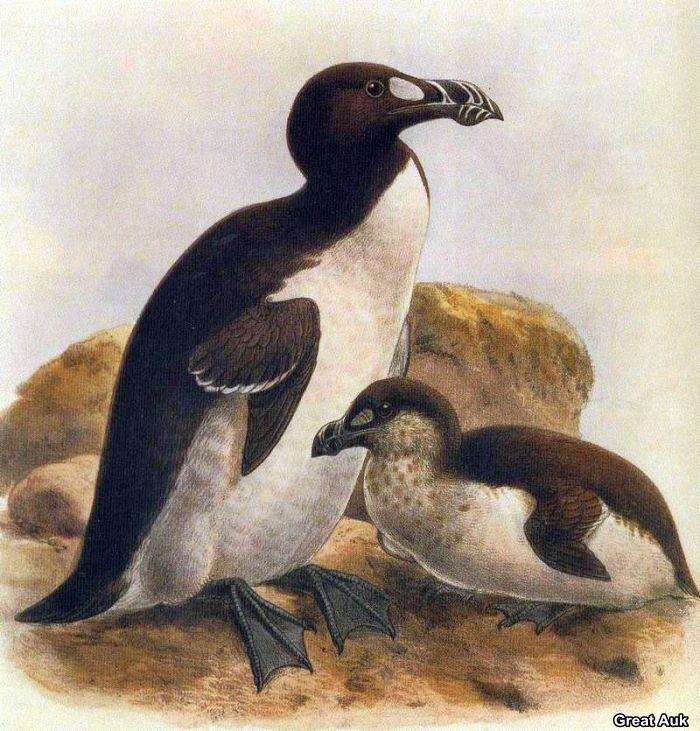
- Because of the “Little Ice age[8]“, a large decline in the Great Auk population was observed by the mid-16th century. These birds became widely exposed to predation and massive human exploitation as their down feathers were plucked for pillow production.
- While laws have prohibited the hunting of Great Auks, a great volcanic eruption during the 1830s almost wiped out the Great Auk population. Unfortunately (in 1844), the last pair of Great Auks was killed as their egg was smashed by merchants to be used as specimens.
![]()
7. Seychelles Parakeet (†Psittacula wardii)
| Kingdom | Order | Family | Genus | Species |
|---|---|---|---|---|
| Animalia | Psittaciformes | Psittaculidae | †Psittacula | †Psittacula wardii |
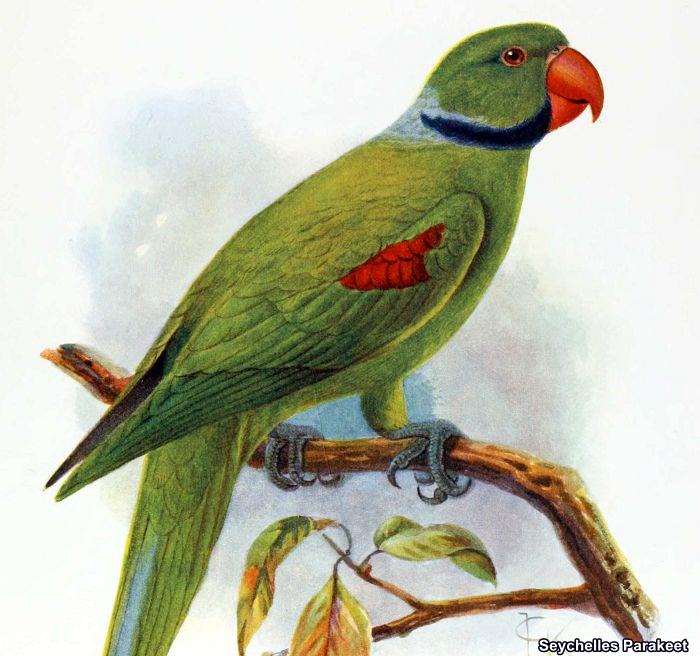
- This bird appeared to be very similar to the Alexander parakeet[9], only smaller and lacking the distinct pink-colored collar. Its body was green with purple patches on its wings and a yellow underside tail.
- The Seychelles parakeet[10] became extinct due to intense hunting pressure, and they are believed to be already gone by 1893.
![]()
8. Laysan Rail (†Porzana palmeri)
| Kingdom | Order | Family | Genus | Species |
|---|---|---|---|---|
| Animalia | Gruiformes | Rallidae | Porzana | †Porzana palmeri |
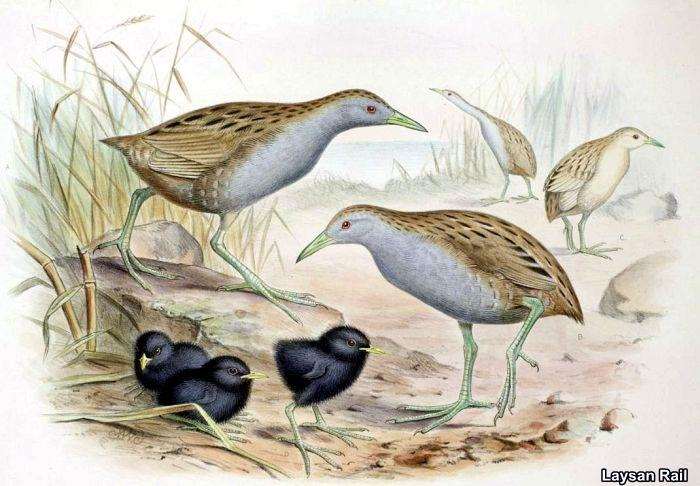
- It has grey underparts, a black tail, red eyes, green legs, and yellow beaks.
- The population of these birds was wiped out due to the introduction of non-native rats[12] in 1944.
![]()
9. Passenger Pigeon (†Ectopistes migratorius)
| Kingdom | Order | Family | Genus | Species |
|---|---|---|---|---|
| Animalia | Columbiformes | Columbidae | †Ectopistes | †Ectopistes migratorius |
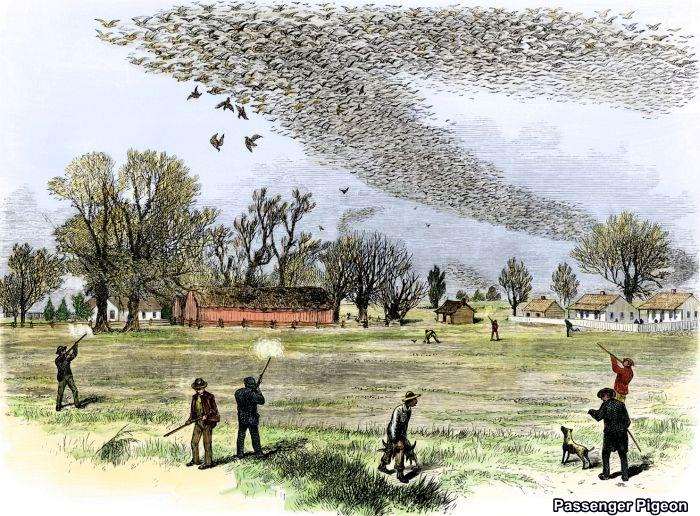
- The Passenger pigeon[13], endemic to North America, is characterized as a noisy low-flying bird that comes in large flocks.
- Despite their overwhelming number, by the early 20th century, not a single bird was left[14] in the wild due to the increase in predation and human exploitation. The above painting shows the shooting of passenger pigeons by hunters in northern Louisiana, Smith Bennett, in 1875.
- The very last Passenger pigeon named Martha was found dead in 1914.
![]()
10. Stephen’s island Wren († Traversia lyalli)
| Kingdom | Order | Family | Genus | Species |
|---|---|---|---|---|
| Animalia | Passeriformes | Acanthisittidae | †Traversia | † Traversia lyalli |
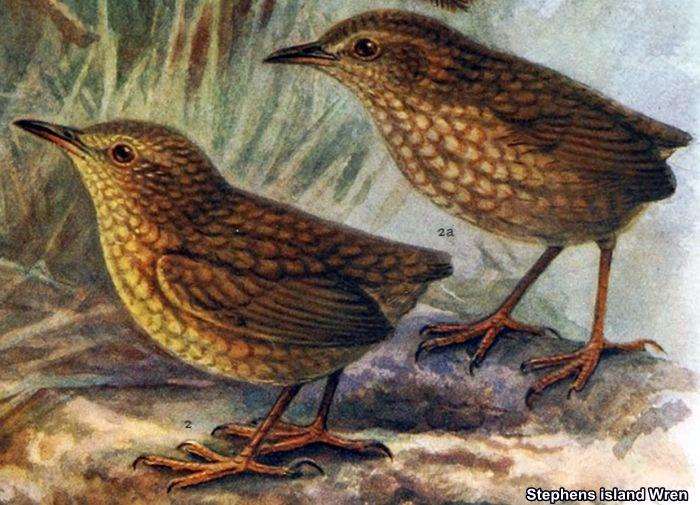
- Interestingly, this bird was flightless as it possessed no keel on its breastbone to attach the muscles necessary for flight. It also had very short wings and loosely attached feathers.
- Because of the extensive island development and widespread predation by the exotic cats, the population of this bird was wiped out in 1895.
![]()
11. Ivory-Billed Woodpecker (†Campephilus principalis)
| Kingdom | Order | Family | Genus | Species |
|---|---|---|---|---|
| Animalia | Piciformes | Picidae | †Campephilus | †Campephilus principalis |
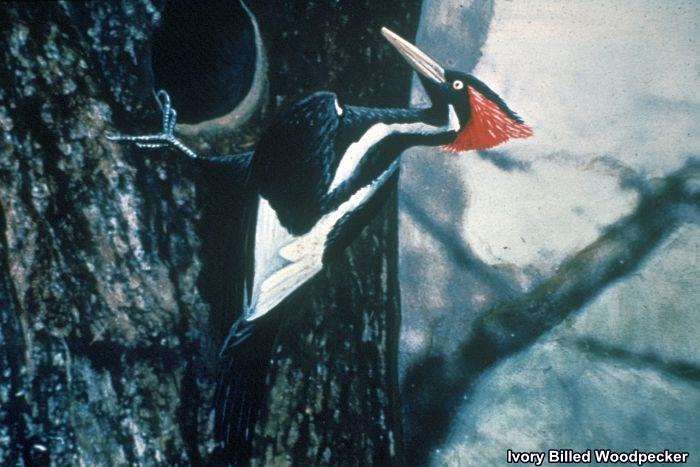
- Its extinction in the mid-20th century is believed to be caused by the destruction of its habitat as well as human exploitation.
- As its name suggests, this bird species was highly notable for its enormous white bill resembling ivory. As a result, these woodpeckers were hunted for their bills to be used as decorations.
![]()
12. New Zealand Quail (†Coturnix novaezelandiae)
| Kingdom | Order | Family | Genus | Species |
|---|---|---|---|---|
| Animalia | Galliformes | Phasianidae | †Coturnix | †Coturnix novaezelandiae |
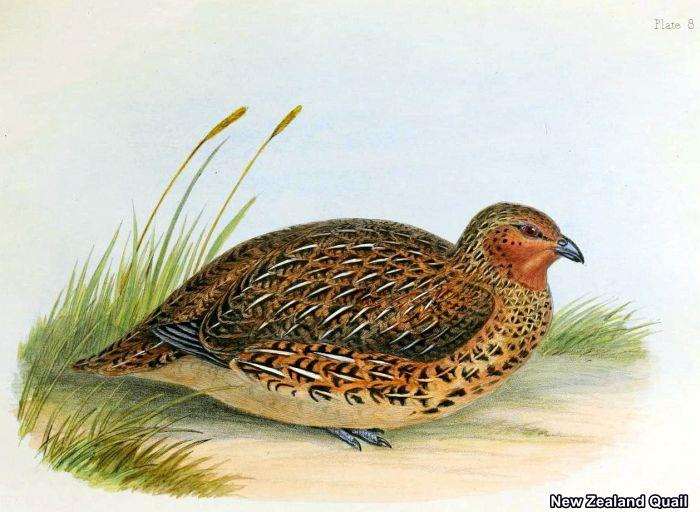
- This genus of birds was composed of small ground birds and was the only representative of the quail and pheasant bird family.
- Unfortunately, this was the first bird species that went extinct after European colonization in the region.
- Only a little information about the biology of this bird is available.
![]()
13. Labrador Duck (†Camptorhynchus labradorius)
| Kingdom | Order | Family | Genus | Species |
|---|---|---|---|---|
| Animalia | Anseriformes | Anatidae | †Camptorhynchus | †Camptorhynchus labradorius |
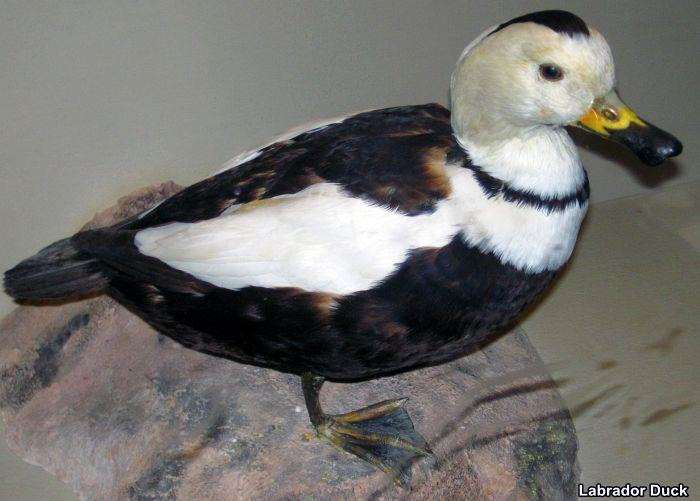
- Also known as the Pied duck[19] , this duck fed on mollusks like mussels.
- Even before its extinction in the 1870s, the Labrador duck was already considered to be rare; however, hunters continued to seek it thus, resulting in its extinction.
![]()
14. Laughing Owl (†Sceloglaux albifacies)
| Kingdom | Order | Family | Genus | Species |
|---|---|---|---|---|
| Animalia | Stringiformes | Stringidae | †Sceloglaux | †Sceloglaux albifacies |
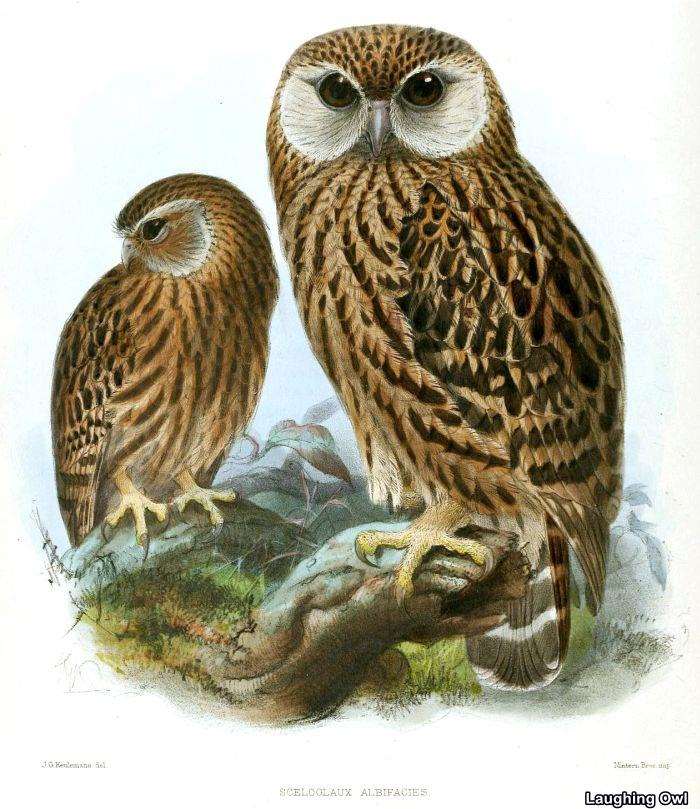
- During the mid-19th century, this bird was still common but slowly decreasing in number.
- The extinction of the Laughing owl[21] in 1914 was highly attributed to the destruction of its habitat and the introduction of exotic species (such as stoats ferrets) that became its predators.
Suggested Reading:
Albino Ferrets
![]()
15. Chatham island Penguin (†Eudyptes chathamensis)
| Kingdom | Order | Family | Genus | Species |
|---|---|---|---|---|
| Animalia | Sphenisciformes | Spheniscidae | †Eudyptes | †Eudyptes chathamensis |
The Chatham Island penguin is a species endemic to Chatham’s Island in the Pacific Ocean, east of New Zealand.
- The Chatham Island penguin[22] is a crested bird of the Eudyptes family, which is characterized by the presence of white and black plumage with distinct yellow eyebrows.
- This penguin became extinct[23] as a result of the arrival of the human population (sometime between 1867 to 1872).
![]()
16. Mauritius Blue Pigeon (†Alectroenas nitidissimus)
| Kingdom | Order | Family | Genus | Species |
|---|---|---|---|---|
| Animalia | Columbiformes | Columbidae | †Alectroenas | †Alectroenas nitidissimus |
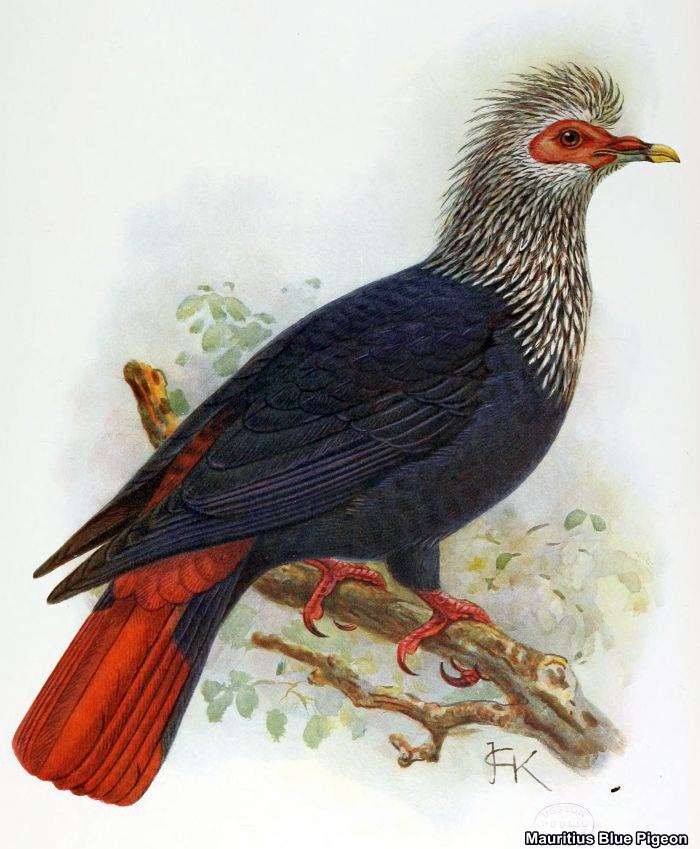
- This bird was very distinct because it somehow resembles the Dutch flag[24] with its white feathers around its head, breast, and neck, blue body feathers, and red tail.
- Like the Dodo bird, also native to Mauritius, this blue pigeon has gone extinct due to human colonization of the islands in the 1600s.
![]()
17. Elephant Bird (†Aepyornis maximus)
| Kingdom | Order | Family | Genus | Species |
|---|---|---|---|---|
| Animalia | Aepyornithiformes | Aepyornithidae | †Aepyornis | †Aepyornis maximus |
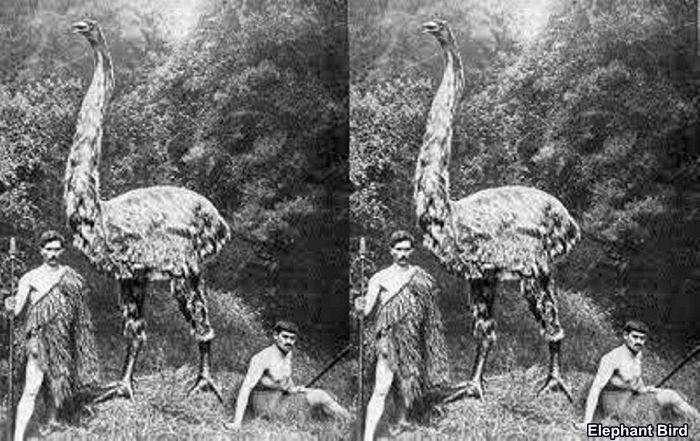
- The Elephant bird is considered the largest bird ever. Like its close relatives, the emus and ostriches, this bird had a massive physique and sharp claws. However, this bird was not capable of running swiftly and even flying.
- Scientists believed that the extinction of this species in the 1700s was mainly because of human exploitation. This bird had eggs big enough to feed an entire family; hence, it is no wonder that they were hunted for food.
![]()
18. Marianne White Eye (†Zosterops semiflavus)
| Kingdom | Order | Family | Genus | Species |
|---|---|---|---|---|
| Animalia | Passeriformes | Zosteropidae | †Zosterops | †Zosterops semiflavus |
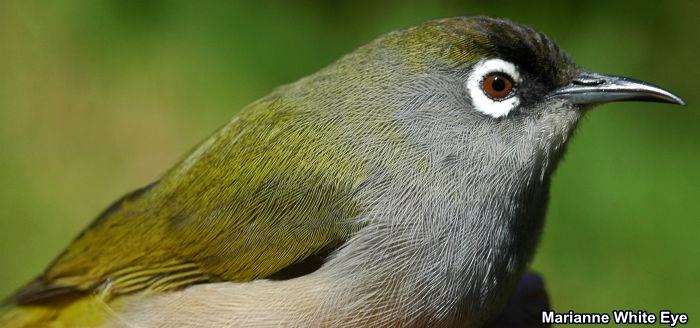
- Very little information is known about this bird, but it is believed to have an overall greenish plumage[27] with a very distinct white eye ring (hence the name).
- This species went extinct between 1870 and the 1900s.
![]()
19. Himalayan Quail (†Ophrysia superciliosa)
| Kingdom | Order | Family | Genus | Species |
|---|---|---|---|---|
| Animalia | Galliformes | Phasianidae | †Ophrysia | †Ophrysia superciliosa |
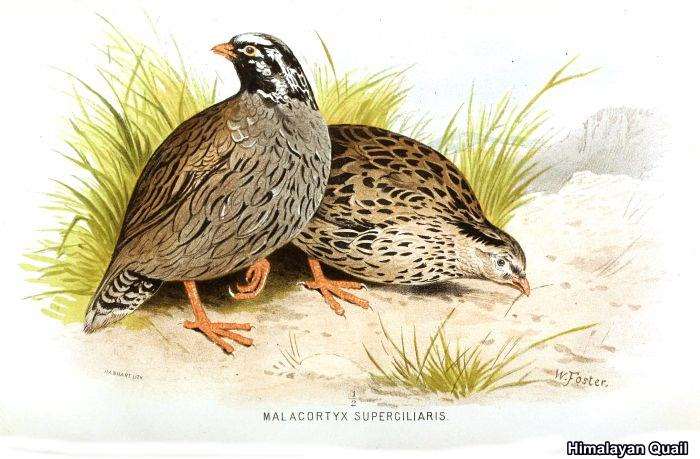
- According to the records[28], this bird had characteristics of both a quail and a partridge. However, one distinguishing feature of this bird was its broad tail which is relatively long compared to other species of quail in India.
- This bird was considered as extinct as it was last verified in 1876[29].
- At present, various attempts to look for this bird in India are being conducted.
![]()
20. Saint Helena Dove (†Dysmoropelia dekarchiskos)
| Kingdom | Order | Family | Genus | Species |
|---|---|---|---|---|
| Animalia | Columbiformes | Columbidae | †Dysmoropelia | †Dysmoropelia dekarchiskos |
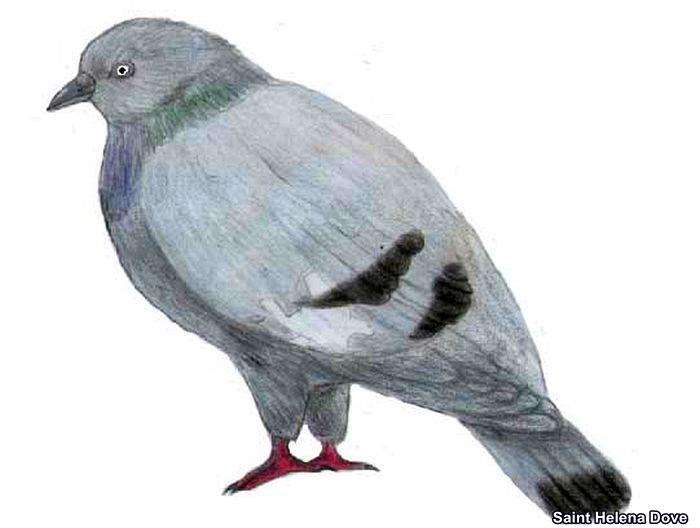
- The genusDysmoropelia[30] is a monotypic genus, meaning it is the only member of that specific genus.
- Years after the island’s discovery (1502), this bird became widely hunted until it became extinct.
![]()
21. Kangaroo Island Emu (†Dromaius baudinianus)
| Kingdom | Order | Family | Genus | Species |
|---|---|---|---|---|
| Animalia | Casuariiformes | Dromaiidae | Dromaius | †Dromaius baudinianus |
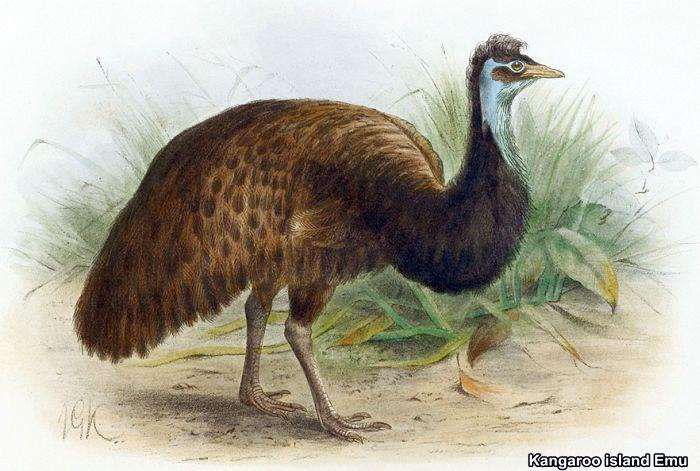
- Compared to the mainland emus, this species of emu was relatively smaller in size.
- This bird species went extinct in 1827 due to extensive hunting and habitat destruction.
![]()
22. Norfolk Island Kaka (†Nestor productus)
| Kingdom | Order | Family | Genus | Species |
|---|---|---|---|---|
| Animalia | Psittaciformes | Strigopidae | †Nestor | †Nestor productus |
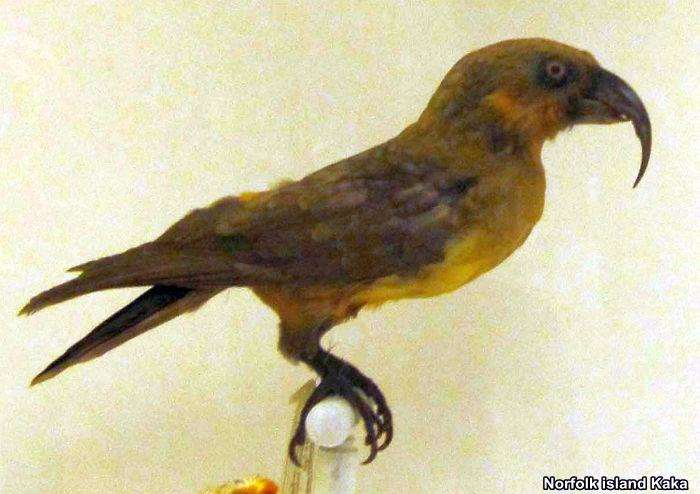
- Scientists believed that this bird had a limited ability to migrate between islands; hence it spent most of its time in the islands where it was given birth.
- During the early 18th century, the population of this bird started to decline, and finally, in 1851, the last known Norfolk Island Kaka died in captivity.
![]()
23. Reunion Shelduck (†Alopochen kervazoi)
| Kingdom | Order | Family | Genus | Species |
|---|---|---|---|---|
| Animalia | Anseriformes | Anatidae | †Alopochen | †Alopochen kervazoi |
The next bird in this extinct bird list is the Reunion Shelduck or Reunion Sheldgoose, which was endemic to the region of Reunion Island situated in the Indian Ocean.
- Little information is known about this organism since only fossils were found.
- The destruction of the forest habitat of the Etang de Saint-Paul is believed to be the main reason why this bird became extinct in 1710[33] .
![]()
24. Hawaiʻi ʻōʻō (†Moho nobilis)
| Kingdom | Order | Family | Genus | Species |
|---|---|---|---|---|
| Animalia | Passeriformes | Mohoidae | †Moho | †Moho nobilis |
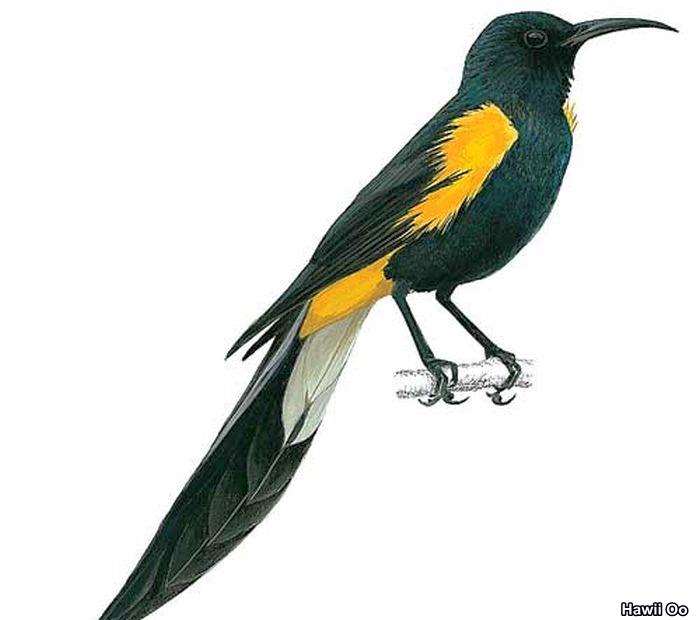
- The arrival of humans on the island, coupled with habitat destruction and the introduction of exotic species, had caused a great decline in the Hawaiʻi ʻōʻō population.
- Unfortunately, this bird became extinct in 1987.
![]()
25. Hawaiʻi Mamo (†Drepanis pacifica)
| Kingdom | Order | Family | Genus | Species |
|---|---|---|---|---|
| Animalia | Passeriformes | Drepanididae | †Drepanis | †Drepanis pacifica |
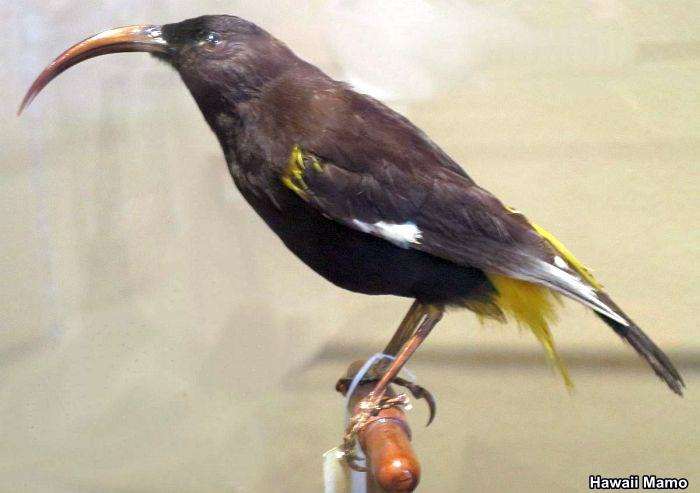
- This bird was very popular because of the color of its feathers (overall black plumage with a yellow undercoat). Because of their feathers, they were extensively hunted by the Hawaiʻian nobilities, thus decreasing their number.
- The exploitation of the Americans in 1898 finally caused the extinction of this bird species.
![]()
26. Guadalupe Caracara (†Caracara lutosa)
| Animalia | Aves | Falconiformes | Falconidae | Chordata | †Caracara lutosa |
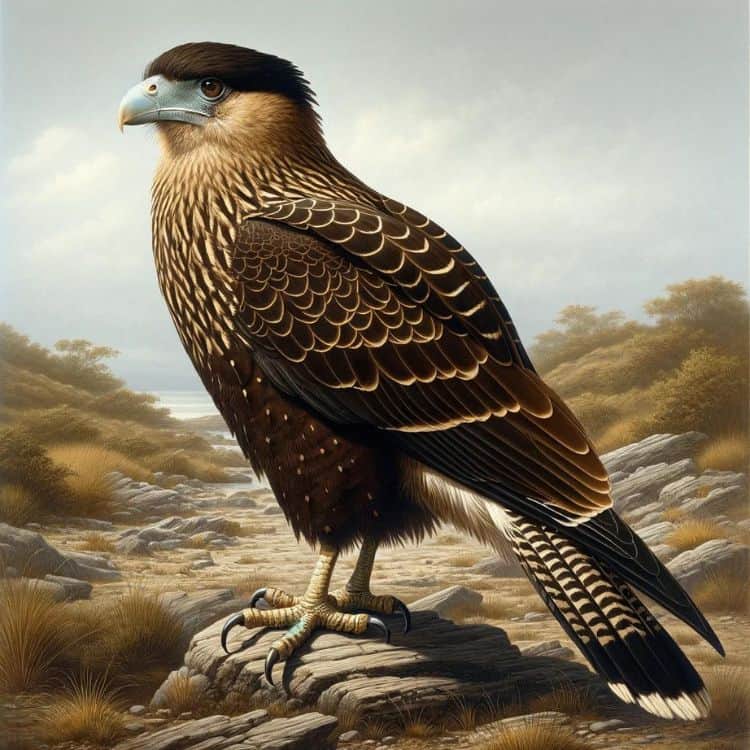
The Guadalupe caracara, scientifically known as Caracara lutosa, was a bird of prey that inhabited Mexico’s Guadalupe Island. It was described as large and robust, bearing a resemblance to the northern caracara but distinguished by its darker, mournful appearance.
- Notably aggressive, this extinct bird of prey was considered a vicious predator, often attacking live young goats and other small animals.
- The caracara’s habitat on Guadalupe Island was severely impacted by human activities, primarily from the introduction of goats which led to overgrazing and significant habitat destruction.
- This change in the ecosystem not only reduced the bird’s natural food sources but also led to conflicts with humans, particularly goat herders.
- In the late 19th and early 20th centuries, efforts to protect livestock led to a campaign of hunting and poisoning against the caracara, driving it to extinction by the early 1900s.
![]()
27. Kākāwahie (†Paroreomyza flammea)
| Animalia | Aves | Passeriformes | Fringillidae | Chordata | †Paroreomyza flammea |
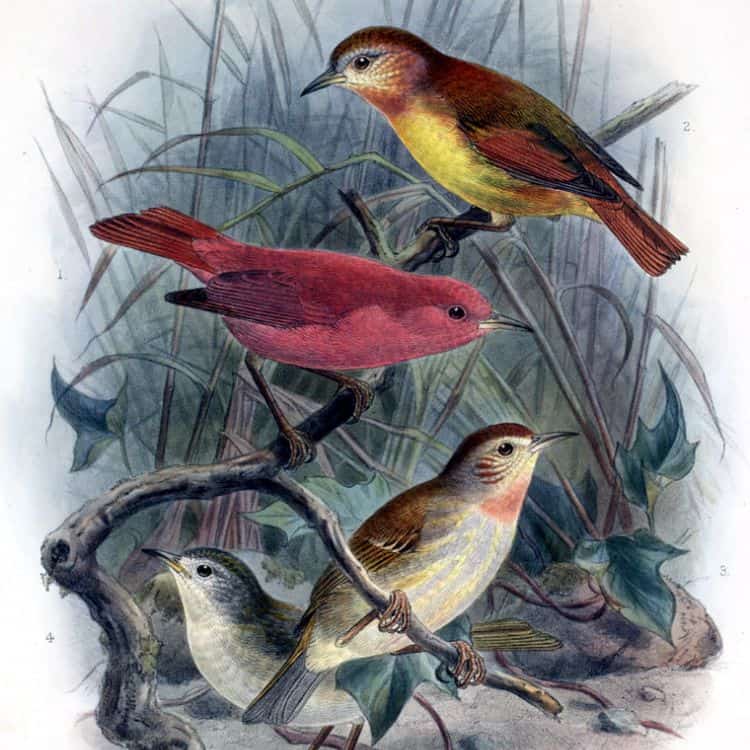
The Kākāwahie, scientifically known as Paroreomyza flammea, was a small honeycreeper native to Hawaii. It measured around 13 cm in length. Males exhibited a bright red plumage with a darker red on the wings and tail, while females were more muted, displaying an olive-yellow color with some red tones.
- Both sexes had a slightly curved bill adapted for their feeding habits.
- The Kākāwahie was found exclusively on the island of Molokai in Hawaii. It inhabited wet forests, primarily at higher elevations where it could find its preferred food sources.
- The bird’s diet consisted mainly of insects, spiders, and nectar, which it foraged from the forest canopy. The Kākāwahie played a crucial role in pollinating native plants and controlling insect populations within its ecosystem.
- The Kākāwahie became extinct in the early 1960s. The primary reasons for its extinction were habitat destruction due to logging and agricultural expansion, the introduction of invasive species such as rats and mosquitoes, and diseases like avian malaria and pox. These factors, combined with the bird’s limited range, led to its eventual decline and disappearance.
![]()
28. Rodrigues Solitaire (†Pezophaps solitaria)
| Animalia | Aves | Columbiformes | Columbidae | Chordata | †Pezophaps solitaria |
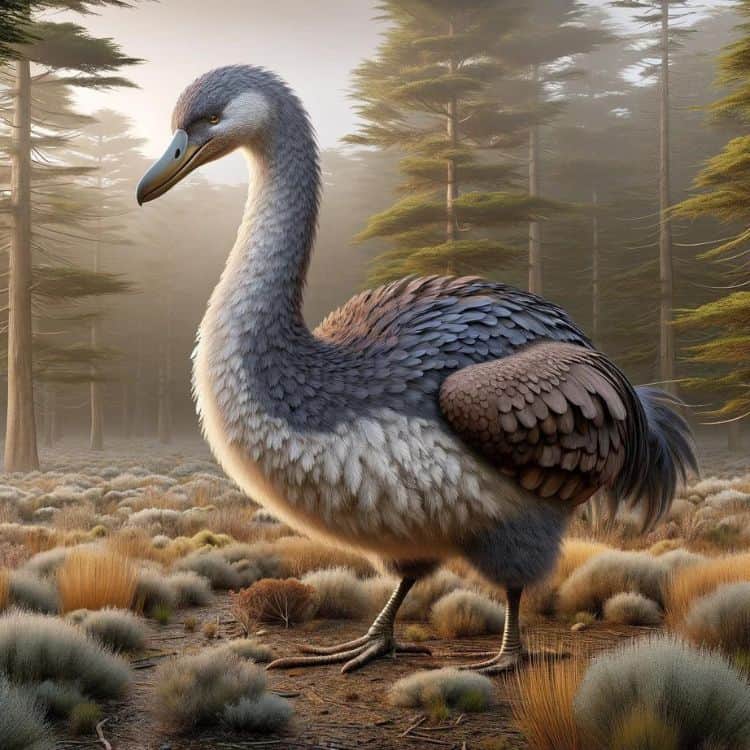
The Rodrigues solitaire, known scientifically as Pezophaps solitaria, was an extinct flightless bird, unique to Rodrigues Island, a part of the Mascarene Islands in the Indian Ocean. This bird, akin in size to a swan, displayed pronounced sexual dimorphism, with males significantly larger than females.
- Its plumage was mainly grey and brown, complemented by a slightly hooked beak, alongside elongated neck and legs.
- These extinct birds were solitary and highly territorial, known for their aggressive nature, particularly during the breeding season. They wielded bony knobs on their wings, likely used in combat with rivals.
- The demise of the Rodrigues solitaire can be traced back to the late 18th century, driven primarily by extensive hunting by humans and predation by introduced animals such as pigs and cats.
- Additionally, the destruction of their forest habitat compounded their vulnerability. Their extinction marked the loss of not only a unique species but also a part of the ecological fabric of Rodrigues Island. Their story is a poignant reminder of the impact human activities can have on isolated ecosystems.
![]()
29. Bushwren (†Xenicus longipes)
| Animalia | Aves | Passeriformes | Acanthisittidae | Chordata | †Xenicus longipes |
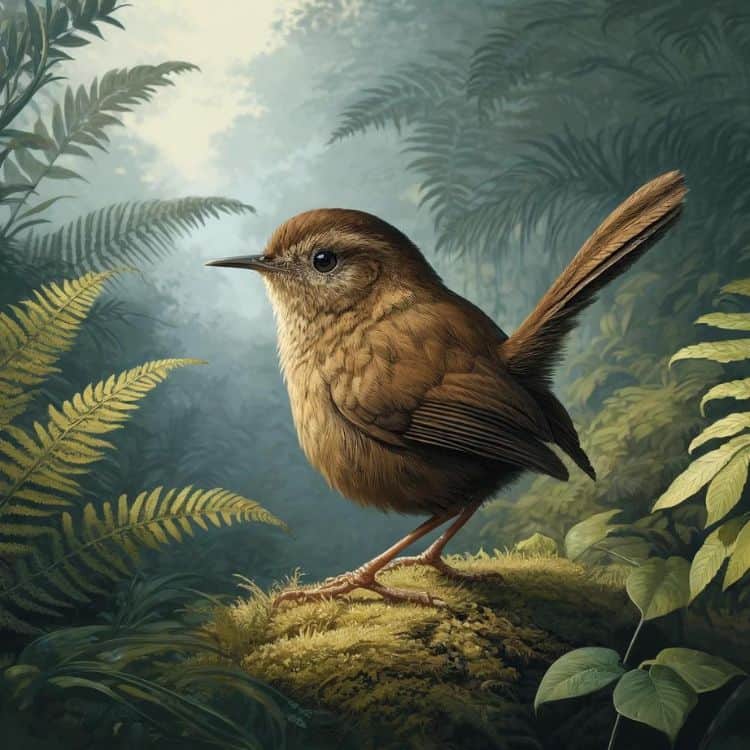
The Bushwren, or Xenicus longipes, was an extinct bird endemic to New Zealand, known for its very small size, around 9 cm in length and 16 grams in weight. It had brownish plumage with a slightly lighter underbelly, suited to its forest habitat.
- Living mostly in the dense undergrowth, it fed on invertebrates, which it foraged from the forest floor and low vegetation. The species was divided into three subspecies, each inhabiting different islands of New Zealand.
- The extinction of the Bushwren was primarily due to predation by introduced mammalian species such as rats and mustelids, coupled with habitat destruction.
- Despite efforts to protect and conserve the species on predator-free islands, the last known individuals died in 1972, marking the end of this unique bird.
![]()
30. Réunion Ibis (†Threskiornis solitarius)
| Animalia | Aves | Pelecaniformes | Threskiornithidae | Chordata | †Threskiornis solitarius |
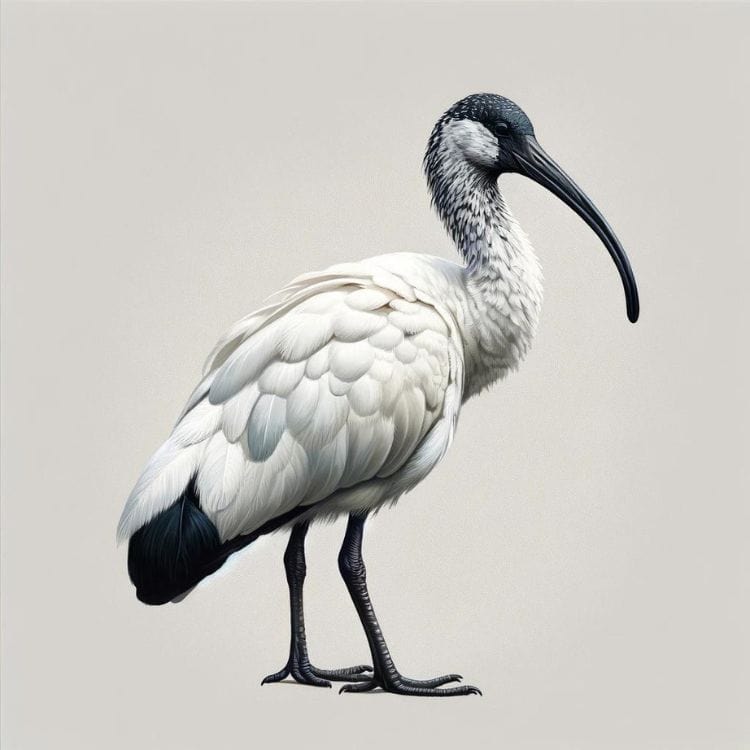
The Réunion ibis, scientifically known as Threskiornis solitarius, was an extinct bird once native to the volcanic island of Réunion in the Indian Ocean. This bird boasted a primarily white plumage, with yellow and gray hues blending into the feathers, and distinctive black wingtips.
- It featured plumes resembling ostrich feathers on its rear, contributing to its elegant appearance. The Réunion ibis was flight-restricted, which likely developed from seasonal fattening that hindered its mobility.
- The bird resided in the mountainous areas of the island, a habitat shift driven by the heavy predation and hunting it faced in more accessible regions.
- Its adaptation to higher altitudes could not safeguard it from human predation, particularly as it was hunted extensively for its tasty flesh. This overhunting, combined with habitat loss due to expanding human settlement and possibly invasive species, led to its extinction by the early 18th century.
![]()
31. Réunion Swamphen (†Porphyrio caerulescens)
| Animalia | Aves | Gruiformes | Rallidae | Chordata | †Porphyrio caerulescens |
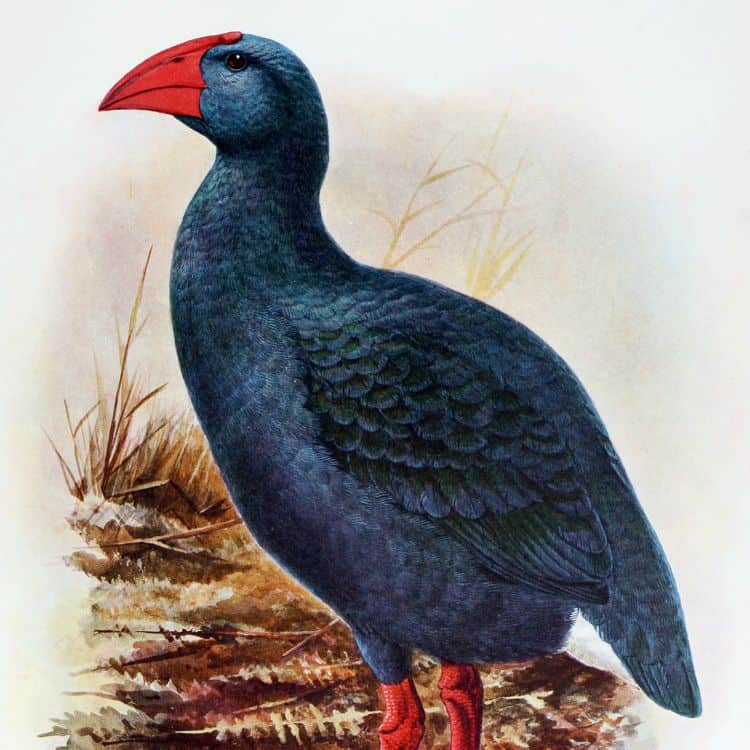
The Réunion swamphen, known scientifically as Porphyrio caerulescens, was a vibrant bird native to Réunion Island, characterized by its striking blue plumage and contrasting red beak and legs.
- This extinct bird, about the size of a chicken, was poorly adapted to flight, which made it especially vulnerable to predators. It inhabited the marshy regions of the island, thriving in its isolated ecosystem until human interference.
- Its extinction in the early 18th century was driven primarily by overhunting, as it was a favored target for food by the settlers.
- The introduction of predatory species such as cats, coupled with habitat degradation due to agricultural expansion, further sealed its fate.
- The Réunion swamphen’s decline is a poignant example of how human activities can dramatically impact and ultimately lead to the extinction of native species.
![]()
32. Bonin Grosbeak (†Carpodacus ferreorostris)
| Animalia | Aves | Passeriformes | Fringillidae | Chordata | †Carpodacus ferreorostris |
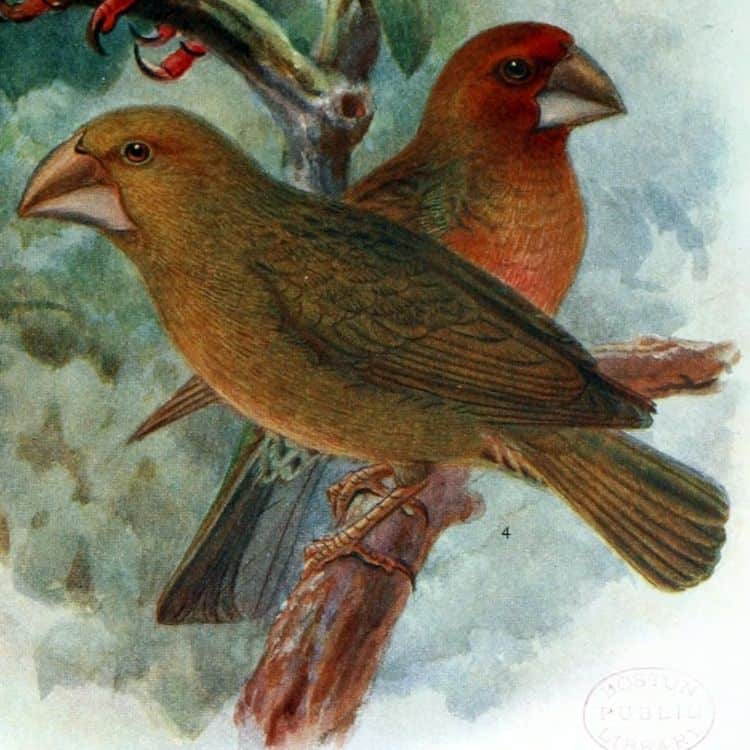
The Bonin grosbeak, or Carpodacus ferreorostris, was a finch native to the Ogasawara Islands, specifically Chichi-jima.
- Noted for its thick bill and striking appearance with variable plumage, it mostly exhibited reddish-brown colors with a larger size compared to similar species.
- Inhabiting the dense underbrush of Chichi-jima, the Bonin grosbeak fed on a diet primarily consisting of fruits and buds.
- These extinct birds’ preference for foraging close to the ground rather than perching in trees reflected its adaptation to the island’s specific ecological niche.
- The Bonin grosbeak met its demise shortly after human settlement began on the islands in the 1830s. The introduction of predators such as rats, along with other invasive species like goats and pigs, devastated its habitat.
- These changes, combined with direct hunting and habitat alteration by settlers, led to the species’ extinction, likely soon after the mid-19th century.
![]()
33. Wake Island Rail (†Hypotaenidia wakensis)
| Animalia | Aves | Gruiformes | Rallidae | Chordata | †Hypotaenidia wakensis |
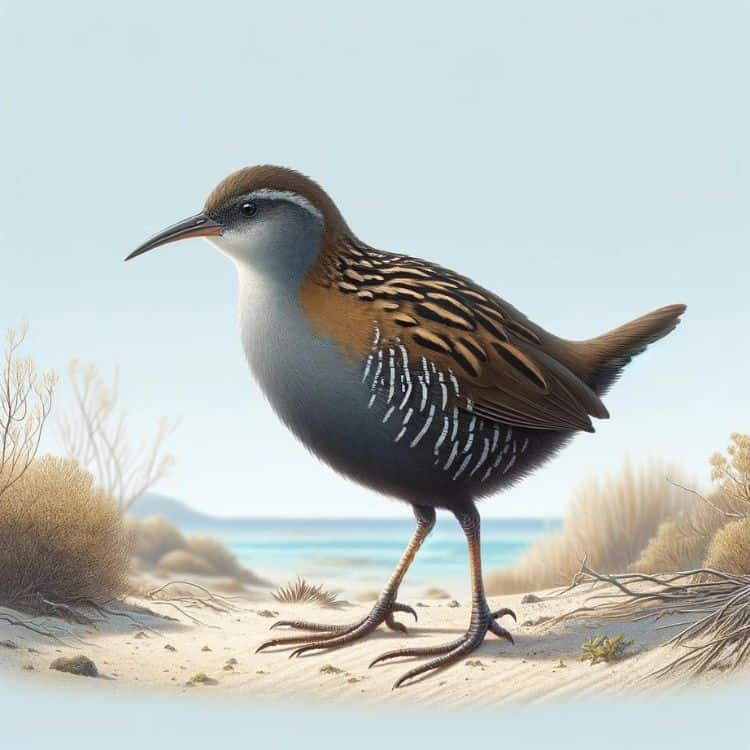
The Wake Island rail, binomially known as Hypotaenidia wakensis, was a flightless bird with a body length of about 22 cm.
- It exhibited dark greyish-brown upperparts and ash-brown underparts with narrow white bars on the belly, breast, and flanks. The bird’s appearance included a grey superciliary stripe above the eyes extending to the bill, which was brown, matching its legs and feet.
- Native to the atolls of Wake Island, this rail thrived in scrub habitats and fed on a diet of molluscs, insects, worms, and seeds, which it foraged from the underbrush.
- Lacking natural fresh water sources, it likely adapted to survive without drinking directly, depending on the moisture content of its food.
- The Wake Island rail became extinct around 1945 during World War II. Its extinction was precipitated by over-hunting by stranded Japanese troops and habitat destruction due to military activities, including extensive bombardment by Japanese and U.S. forces. This combination of factors led to the rapid disappearance of the species.
![]()
34. Red Rail (†Aphanapteryx bonasia)
| Animalia | Aves | Gruiformes | Rallidae | Chordata | †Aphanapteryx bonasia |
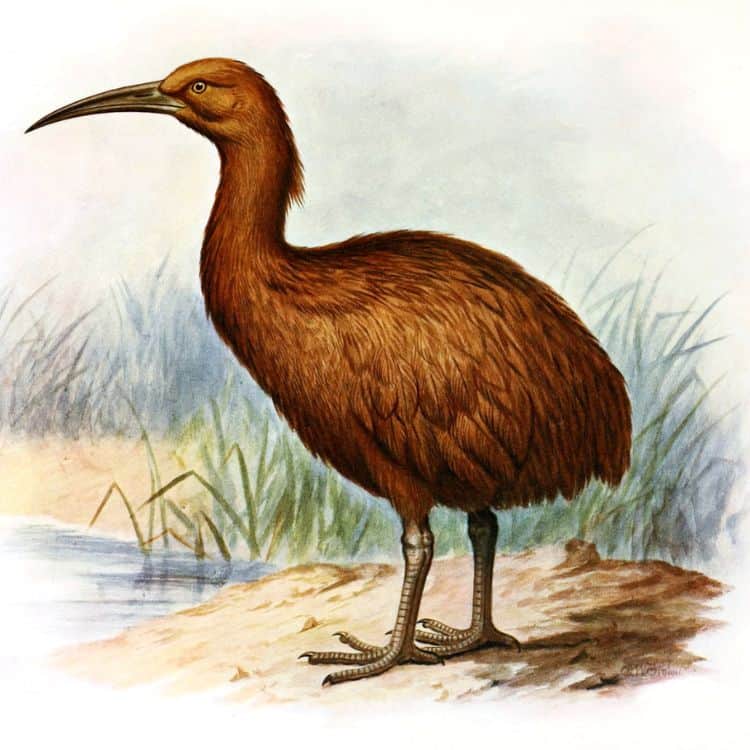
The Red Rail (Aphanapteryx bonasia) was a flightless bird endemic to Mauritius, described as slightly larger than a chicken with reddish, hair-like plumage and dark legs. Its long, curved beak and small wings, along with slender legs, marked its distinct appearance.
- The bird’s habitat was likely the dense forests of Mauritius, where it fed on invertebrates. Damage to snail shells found on the island suggests they were part of its diet. The bird was known for its attraction to red objects, a trait exploited by hunters.
- The Red Rail went extinct around 1700, primarily due to human hunting and the introduction of invasive species.
- Despite its capability to run swiftly, it could not escape the extensive predation pressures and habitat changes brought by human colonization.
![]()
35. Aldabra Brush-warbler (†Nesillas aldabrana)
| Animalia | Aves | Passeriformes | Acrocephalidae | Chordata | †Nesillas aldabrana |
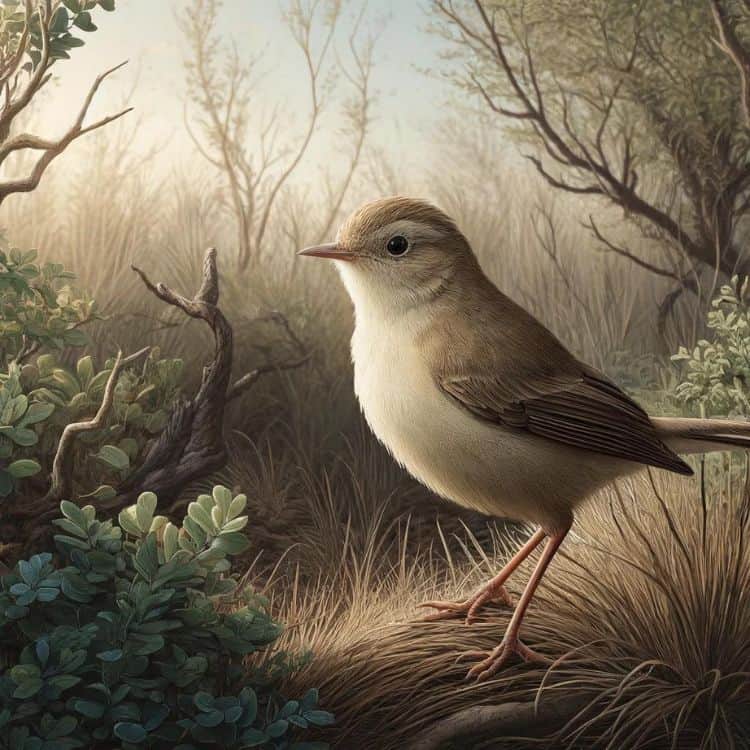
The Aldabra brush warbler, Nesillas aldabrana, was a small, extinct bird that inhabited the Aldabra atoll in the Seychelles.
- These extinct birds had a subtle plumage of dun on the upper parts and paler underparts, with a total length of 18 to 20 cm. This bird was adapted to dense undergrowth, making it elusive and primarily known for its distinctive chirruping call.
- The Aldabra brush warbler’s habitat was the dense scrub of Aldabra, where it foraged for insects and other small invertebrates.
- It was a shy species, difficult to observe except by its call, and lived in a very limited area, which made it vulnerable to environmental changes.
- The species was last observed in 1983, and its extinction was confirmed in 1986. Factors leading to its extinction included habitat degradation and the introduction of invasive species such as rats and cats, which likely preyed on the warbler and its eggs.
- The bird’s restricted range and small population size made it particularly susceptible to these threats.
![]()
36. Haast’s eagle (†Hieraaetus moorei)
| Animalia | Aves | Accipitriformes | Accipitridae | Hieraaetus | †Hieraaetus moorei |
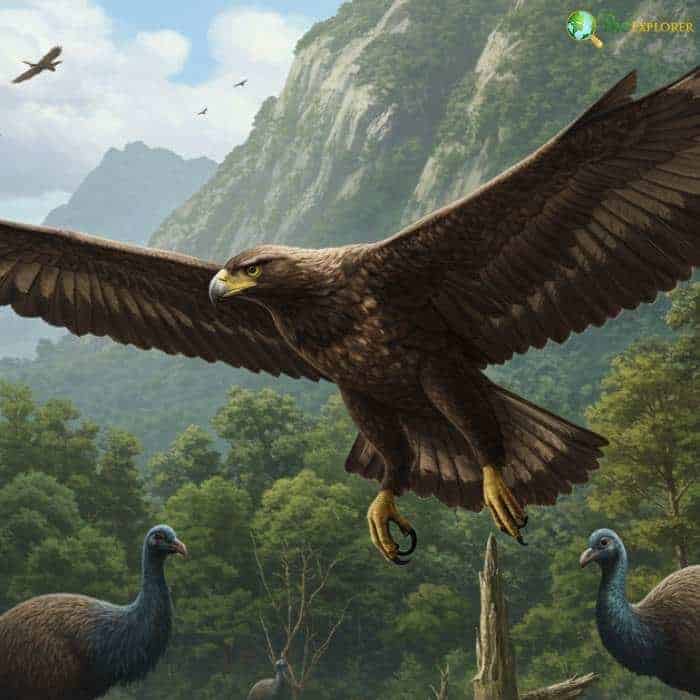
Haast’s eagle was an evolutionary marvel that dominated New Zealand’s skies until approximately 1445 CE.
- Weighing up to 15 kg (33 pounds), these colossal extinct birds evolved rapidly from small eagle ancestors in just 1-2 million years—one of the fastest size increases known in vertebrate evolution.
- Despite its enormous body, it maintained a relatively modest 2-3 meter wingspan, optimized for forest hunting rather than soaring.
- Most remarkably, this extinct bird routinely killed moa weighing up to 200 kg—prey 15 times its own size. Recent research suggests it combined eagle-like hunting talons with vulture-like feeding habits, potentially sporting a bald head like modern vultures.
- This aerial giant appears in Māori rock art and legends as the fearsome Pouākai.
![]()
Reasons Why Birds Are Becoming Extinct?
Birds are becoming endangered or even extinct for an array of reasons:
- The first reason is Habitat loss due to human-made urban development activities (i.e., deforestation, industrialization, etc.), natural catastrophes, cell phone towers with amplified frequencies more than recommended levels, and climate change.
- One main reason birds go extinct is hunting and poaching. The introduction of non-native species (examples: rats, snakes) to the environment also disturbs the birds’ population since these animals make the birds nesting on the trees and ground very unsafe to hatch or raise the off-springs.
- Birds starve for food due to the shortage of food resources, or other bird species compete for the same food resources in the ecosystems.
- Bycatch of marine birds in fisheries occurs regularly when birds such as albatrosses and petrels inadvertently get tangled in gill and trawl nets, causing them to lose their lives.
- Pesticides play a major destructive role in birds’ population. The concentrated pesticides on the field get stuck on the grains birds consume. This, in turn, alters the hormonal balance in the birds and results in weak eggs which cannot survive too long.
- Another reason is Biological Magnification (i.e., chemical toxins travel from the lowest chain species in the ecological pyramids to top of the chain). For example, man-made contamination in the ocean bed gets into the fish diet, which is then consumed by seabirds. The toxic poisoning makes the bird infertile or even fatal.
- In some rare situations, losing a bird species is inevitable. The bird might be a new species that evolved from other bird species (such as cross-breeding) and lack adaptability and is extremely sensitive to new environmental changes.
In summary, if humans take conscious initiatives to conserve the environment, the birds going extinct can be reversed. Birds also share the planet earth, and it is not just for humans!
![]()
With the kind of technology we have at present, it is not impossible to retrieve these extinct organisms. However, the real and more important question is whether we want these species back.
![]()


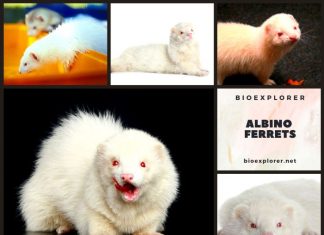
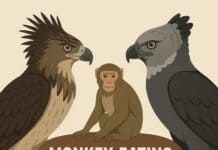
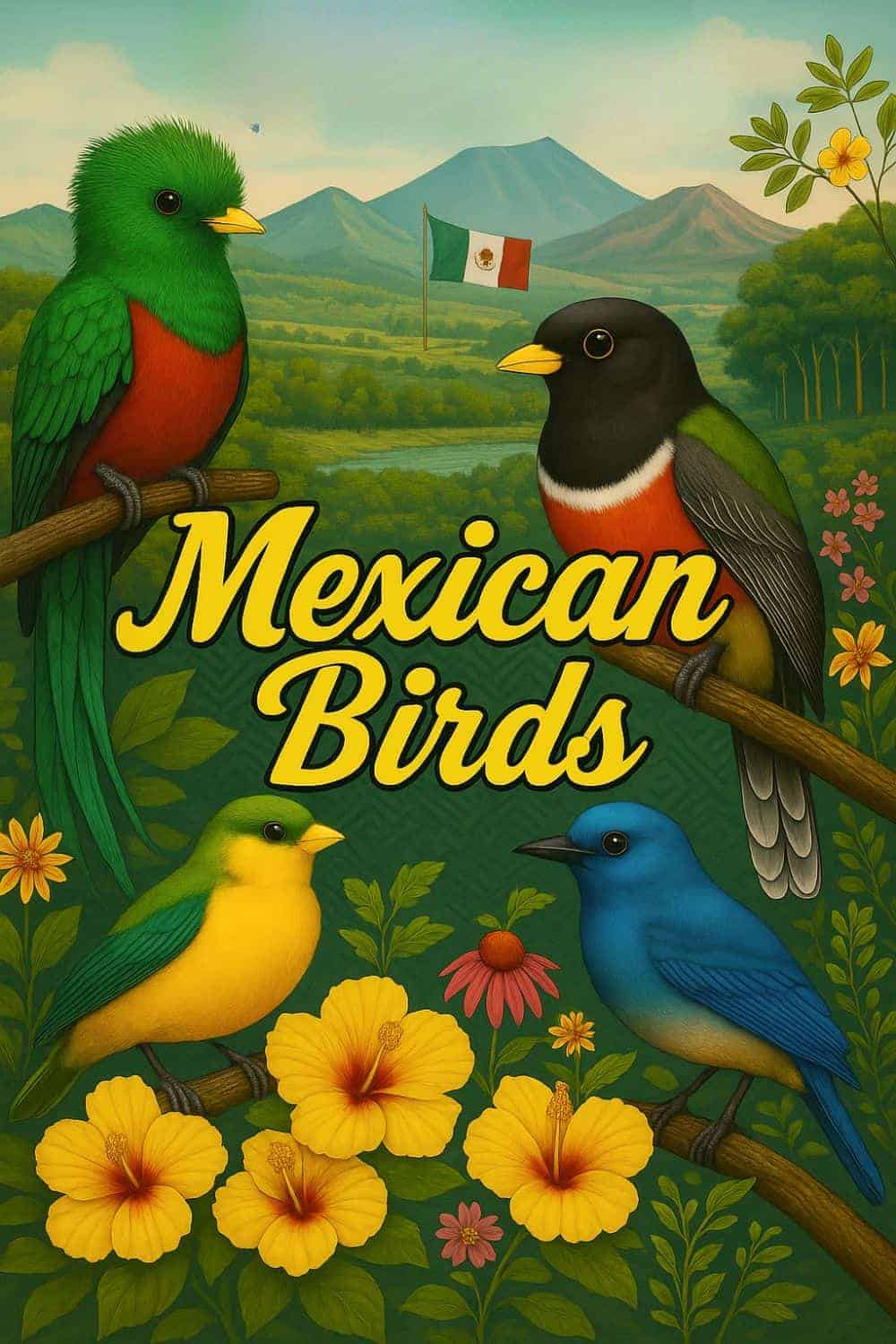
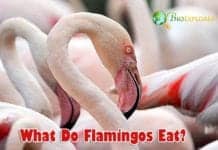
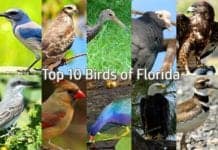
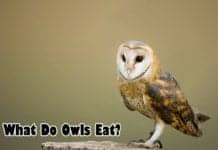











First I would like to say that your information on Extinct Birds is displayed very well. This is the most concise information that I have been able to find on this topic, and the photos help to understand what these lost birds represent. It is sad to know that so many beautiful birds have become extinct, in most part, due to human exploitation.
On reading the reasons for this loss, I must note that you might want to add one more increasing problem that birds and their habitats are facing and will be increasing over the years. That is land development for solar wind farms. Yes, it is happening already. Deforestation has started to acquire enough land needed for these massive turbines. Also, the increase in the deaths of birds due to impacts with the blades will only be increasing. Perhaps it is not as detrimental as other harms; however, we have only just begun to scope out more and more land needed for these forms of energy.
Great work on your part, but all causes of bird loss need to be addressed in order to save as many as possible.